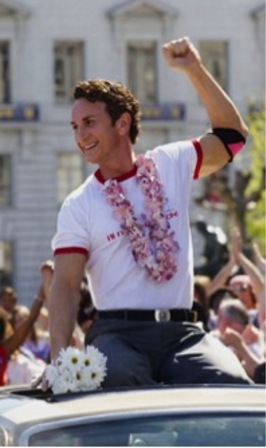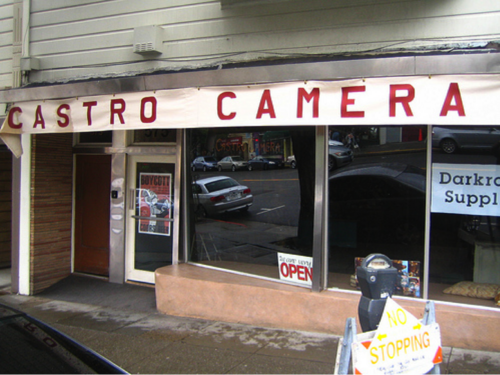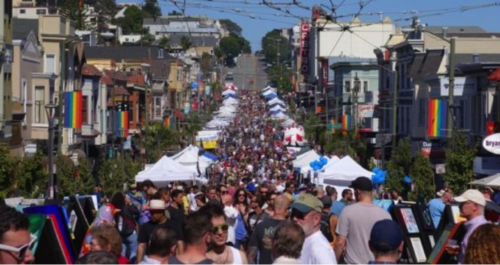-
The empowerment of the LGBT community
Coming out
At the beginning of the movie, Harvey Milk is depicted as a closeted homosexual living in New York City and working as a financial analyst before going hippie and leaving for San Francisco to live as an openly gay person. Actually, in the documentary The Times of Harvey Milk (1984), Harvey Milk’s friends stated that they believed he had led a very conventional life in New York. The New York City Milk also obliged his boyfriends to conceal their shared sexual orientation. We can see it at the beginning of the movie, when Milk warns his lover Scott Smith that he could be arrested for kissing him in the subway and invites him at his place so that they can be safer But Milk hated that life. Living in terror and shame and pretending to be someone else was considered by Milk and many others to be close to assassination. He finally finds his true self and manages to be more satisfied with his life by coming out and leaving New York for San Francisco, considered to be a gay enclave and a more progressive city than the rest of the US.
According to Sara Villa's article ("Milk (2008) and The Times of Harvey Milk (1984): The Double Filmic Resurrection of the Mayor of Castro Street") he biopic shows that Milk considered coming out as a form of salvation and rebirth for gays: they could finally be over with pretending to be someone else and even sometimes start a new life from scratch by breaking all ties with their intolerant relatives and finding a new family among the LGBT community. As a consequence, once in San Francisco, Milk kept encouraging gays to come out. Milk considered it was the best way to fight against discrimination and homophobia because gays would cease stopping being invisible to society.
In that matter, according to Sara Villa's article mentioned above, the recurring theme of the toxic and dreadful closet is very present in Milk’s political discourse. He described the closet as a form of death. The biopic takes up some famous quotes of Milk dealing with the issue. We can see it in "That's What America Is," speech given on Gay Freedom Day in San Francisco on June 25th 1978 and that is represented on screen. The movie tried to give a faithful representation of that day: Sean Penn is wearing the same “I’ll never go back” t-shirt as that of Milk and pronounces an extract of the politician’s famous speech:
“Gay brothers and sisters,... You must come out. Come out... to your parents... I know that it is hard and will hurt them but think about how they will hurt you in the voting booth! Come out to your relatives... come out to your friends... if indeed they are your friends (…) But once and for all, break down the myths, destroy the lies and distortions. For your sake. For their sake. For the sake of the youngsters who are becoming scared by the votes from Dade to Eugene.”The representation on screen of the June 1978 San Francisco Gay Freedom Day once again mingles fiction with reality and on some aspects the movie has a documentary approach. Indeed, some archival-filmed extracts of the gay parade are inserted in the movie. According to Sara Villa's article, the “real” Cleve Jones, one of Milk’s activist friends, can be seen as Don Amador on the stage where Milk’s protagonist is giving his speech. In that way, Gus Van Sant followed a documentary approach to pay tribute to Milk and to his legacy.
On the left: Harvey Milk at the 1978 Gay Freedom Gay Parade in San Francisco with his “I’ll never go back” T-shirt.
On the right: Sean Penn at the 1978 Gay Freedom Gay Parade represented on screen.
Milk’s and the LGBT community’s common fates
The biopic parallels Milk’s growing self-affirmation and political rise with the empowerment of the LGBT community. The fate of Milk and that of the LGBT community are linked in this movie that depicts the birth and formation of a well-structured political movement. Milk undergoes a personal transformation as well as his friends, and on a wider scale, the LGBT community. Indeed, closeted conventional New York City Milk turns into a San Francisco hippie before transforming into a successful businessman, and later on, a powerful politician, whereas the LGBT community progressively supports its new leader and becomes an organized and politically visible community. It illustrates what Milk actually thought about his role he played in the civil rights movement. In the biopic, Milk’s protagonist is seen recording some quotes on a tape, which the politician actually recorded on November, 18 1977:
“I have never considered myself a candidate. I have always considered myself part of a movement, part of a candidacy. I considered the movement the candidate.”
As we can notice, Milk did not want to be considered as a hero. Above all, he deemed he was part of a “movement”, the one of democracy, which was bigger than him. These very words minimize the significance of the individual versus a collective movement.
The economic boom and growing political power of the LGBT community
In the biopic, his rise as a businessman and later on as a politician parallels the empowerment of the LGBT community and the transformation of the Castro district.
Milk arrived with his lover Scott Smith in San Francisco in 1973. They opened a camera store called Castro Camera on Castro Street, in the gay district of Castro. The latter had started being a gay enclave since the 1950s and it had become symbolic of San Francisco’s gay liberation movements and other alternative cultures since the 1967 Summer of Love. In the early 1970s, the Castro district and its outskirts experienced serious transformations with massive arrivals of gays. The filmmaker took pains to recreate the original location of Milk’s and Smith’s shopfront that was recreated on the site of the original camera store.
Harvey Milk in front of his shop Castro Camera.
The location at 575 Castro Street was carefully recreated as a set for Harvey Milk. The interior decoration was also recreated and includes an old red couch and a barber’s chair that were originally present.
“Gay economic self-sufficiency” in San Francisco
The movie points out the hostility towards the two gay newcomers who were starting from scratch in San Francisco, in 1973. Indeed, even in the district of Castro, a lot of people were hostile to the growing presence of homosexuals. It was particularly the case of the Catholic middle-class families living in the area. In the movie, one of the shopkeepers, who runs a business next to their shop, warns the newcomers that the Eureka Valley Associations will remove their shop’s license in the name of “God’s Law”. It shows how hard it could be for gays to start a business, since their shops could be boycotted or closed. Thus, Smith and Milk could have gone bankrupt.
However, the movie shows that the couple rose as businessmen by relying on the demands of the LGBT community: Smith and Milk started their business with gay clients and had success. As stressed in the movie, their shop even became a gay enclave. Milk was part of a community of gay entrepreneurs that only consumed products coming from gay shops. As a result, gay and gay-friendly shops thrived. As showed in the movie, the non-friendly gay shops went bankrupt. It was illustrated at the beginning of the movie when truck unionist Allan Baird (played by himself) asked Milk’s protagonist to make gays of Castro and its area boycott Coors beer: the number one Castro beer finally collapsed. In exchange, the truck driver union agreed to hire openly gay drivers. Thus, one can see the influence of the gay community that progressively managed to gain empowerment first by becoming economically powerful. In her article “San Francisco’s Castro district: from gay liberation to tourist destination” (2011), Nan Alamilla Boyd states that Milk is a representative of this “gay capitalism” or “gay economic self-sufficiency” that enabled the “economic miracle-on-Castro Street”. As showed in the movie, he was an early participant in the Eureka Valley Promotion Association, a group of Castro Street merchants who consolidated the Castro’s business community. The Castro became a gay-spending zone: for instance, since 1970, the number of new gay restaurants in the Castro had risen by 214%.
According to Nan Alamilla Boyd, in her 2011 article "San Francisco's Castro district: from gay liberation to tourist destination", Journal of Tourism and Cultural Change another organization played a major role in the economic development and the rise of political power of the LGBT community: the little-known Golden Gate Business Association (GGBA), which was created in 1974. It aimed to create a gay business community that had the power to influence local politics. It functioned like an elite club and its members were gay business owners who paid dues and benefited from more visibility in the world of gay business. Since its creation, the GGBA grew steadily (in 1976 the organization had 150 members, whereas by 1980 the membership had been multiplied by four) before becoming a charitable organization and political force. Since the very beginning of the 1979, it has raised funds for charitable organizations like the Gay Pride Parade and has worked with local television and radio to produce friendly images of gay community via events like tea dances. It also strove to cultivate relationships with more conservative politicians like US Senator S.I. Hayakawa. In the 1980s, the GGBA started more overt political involvement, lobbying efforts to support anti-discrimination legislation: the association worked with two national organizations (the Gay Task Force and the Gay National Lobby) to convince US Senator Alan Cranston and US President Jimmy Carter to support some gay political fights.
Even if the GGBA is not mentioned in the biopic, its first president, lawyer Richard Stokes, is. In the movie, he is presented as a powerful and wealthy gay civil rights lawyer. Although the movie does not represent all the consequences of the Castro’s economic miracle, it stresses the influence of some important gay figures that acquired visibility and political power by becoming successful businessmen. We can see it when Milk’s protagonist visits lawyer Rick Stokes and Goodstein, the owner of a gay magazine.
The Castro Street Fair on Castro Street. It was founded by Harvey Milk and the Castro Valley Association, in 1974. Nowadays, it still attracts thousands of buyers and tourists.
From Mayor of Castro Street to supervisor
Milk’s influence and economic success earned him the nickname of the “Mayor of Castro Street”. Indeed, he took several initiatives of leadership in the district. In 1974, he ran for supervisor for the San Francisco Board of Supervisors but lost. However, he was starting to be taken seriously as a candidate and decided to run again for supervisor in 1975. Milk's campaigning earned the support of the teamsters, firefighters, and construction unions. Castro Camera became the center of activity in the neighborhood. He finally lost, but from a few votes. Although he had not been elected supervisor, he was influent. Indeed, he campaigned for George Moscone who became San Francisco’s Mayor in 1975. Earlier that year, Moscone, who was a member of the California Senate, had repealed the sodomy law (considering homosexuality as a crime) in the California State legislature in order to have the gay votes. He acknowledged Milk's influence in his election by visiting Milk's election night headquarters, thanking Milk personally.
Milk finally became Member of the San Francisco Board of Supervisors from District 5 for the first time on January 8th 1978 after his fourth campaign. It was due to the support he had gained from several other minorities and people who felt victims of injustice. H. Milk was not only a candidate representing gays but was more largely a civil rights movements candidate: he supported Asians, Blacks, seniors,... He also advocated social justice, fighting against the gap between the rich and the poor. For instance, he tried to stall the gentrification of the Castro district by sponsoring a bill that banned the conversion of Castro Street apartments into professional offices. The movie highlights how Milk represented hope for a lot of citizens who felt left out by the establishment.
The movie takes up an extract from his “Hope Speech” that could illustrate Milk’s faith in making society better for everyone: “And the young gay people in the Altoona, Pennsylvanias and the Richmond, Minnesotas who are coming out and hear Anita Bryant in television and her story. The only thing they have to look forward to is hope. And you have to give them hope. Hope for a better world, hope for a better tomorrow, hope for a better place to come to if the pressures at home are too great. Hope that all will be all right. Without hope, not only gays, but the blacks, the seniors, the handicapped, the us'es, the us'es will give up”.
Harvey Milk during his campaign in 1975. After losing once more in 1975, he decided to change his look: he cut his ponytail and tried to look less hippie and more “serious”.
A brand new type of uncloseted gay politician
Because he presented himself as openly gay, Milk stood out as a brand new and uncloseted type of political candidate for the LGBT community, as stated in Sara Villa's 2009 article ("Milk (2008) and The Times of Harvey Milk (1984): The Double Filmic Resurrection of the Mayor of Castor Street"). As the audience can notice in the movie when Milk visits Rick Stokes at his place, not everyone among the LGBT community agreed. Indeed, as showed in the movie, Rick Stokes had gained the help of liberal politicians and preferred to support of gay-friendly heterosexual candidates rather than openly gay ones. Therefore, we could say that Milk changed American politics. He managed to make the LGBT community visible and powerful by becoming part of the political establishment, which was a crucial turning point in the civil rights movement. The movie stresses this important aspect when thrilled Milk’s protagonist tells Mayor Moscone that he is “a homosexual with power”, echoing a sentence Milk actually said in an interview: “They [politicians] now have to deal with me and it feels fantastic”.
Supervisor Harvey Milk and Mayor George Moscone at the signing of San Francisco’s gay rights ordinance in April 1977. This scene is represented in the movie.
Proposition 6 and hatemongers
Milk was a supervisor at the San Francisco Board of Supervisors during eleven months before being assassinated. He improved the conditions of living of the LGBT community during his mandate and fought against several homophobic political opponents. The movie represents the fight that Milk led against the passing of California Proposition 6 proposed by Republican California State Senator John Briggs. The latter organized a referendum in November 1978 all across California in order to make the bill pass, but it finally did not. Proposition 6 aimed to remove all gay and lesbian public school employees or their supporters from their jobs.
One of Briggs’s main supporters was singer Anita Bryant. As I found on Wikipedia, she had led several campaigns around the country to repeal local anti-discrimination ordinances, including campaigns in St. Paul, Minnesota; Wichita, Kansas; and Eugene, Oregon. The movie represents one of A. Bryant’s highly publicized 1977 campaign to repeal the Dade County (Florida) ordinance that prohibited discrimination on the basis of sexual orientation. She was the leader of political coalition “Save Our Children” created in 1977 and that supported Briggs during his campaign for the passing of proposition 6. A. Bryant and J. Briggs both considered that homosexuality could pervert children and thought that homosexuals tried to make children turn gay, especially at school. Indeed, Anita Bryant stated: "As a mother, I know that homosexuals cannot biologically reproduce children; therefore, they must recruit our children". Bryant and Briggs thought that homosexuality was “a real threat to the survival of the country”: according to them, there was a risk that everybody could turn gay and that no more Americans would exist. They did not want to grant homosexuals the same rights as that of the other citizens because they considered them as criminals. According to Bryant, "If gays are granted rights, next we'll have to give rights to prostitutes and to people who sleep with St. Bernards and to nail biters”. Proposition 6 was thus seen by Briggs and his supporters as a matter of life and death.
The hostile atmosphere that reigned during that turning point period of the civil rights movement was represented on screen: for instance, civil rights activists were represented at work and the September 6th 1978 filmed debate between Briggs and Milk was recreated in the movie. However, the movie preferred to have Bryant’s original voice and image to maybe represent the homophobic hostility that prevailed at the time in a most realistic way.
The audience is plunged into the frantic world of the civil rights movement activists that are driven by their hopes to change society. We can say that it is one of the aspects that make the movie exciting: the viewer is behind the scenes of Milk’s campaign and shares the LGBT community’s hopes.
Anita Bryant’s tracts for her campaign advocating the voting of Proposition 6 that aimed to reduce gay rights in 1978.
-
Commentaires









Excellent in-depth post about how Harvey Milk represents the gay movement and both promotes and symbolizes its empowerment. You use your scholarly sources like Boyd’s article well to show how the plot of the movie conveys historical knowledge. But beware of borrowing straight from websites without stating your source (as you seem to do from the Wikipedia page on Anita Bryant) because this is plagiarism… Well-written post with very few English mistakes